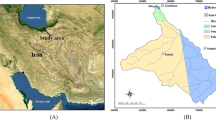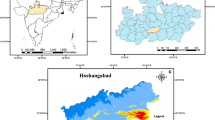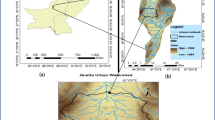Abstract
The daily rainfall-runoff relationship in an experimental watershed was modeled using a statistical method and an artificial neural network method. The estimations were examined and a performance evaluation was done. It was seen that the ANN method, FFBP (Feed Forward Back Propagation), provided closer flow estimations reproducing the shape of the observed hydrograph more realistic. The superiority of FFBP was reflected in the performance evaluation criteria. The extreme flows, i.e., high and low flows, were relatively better approximated by FFBP indicating its promise as a useful tool for hydrologic studies such as flood modeling. The Rational Method was also used, as a conventional tool, to predict the maximum discharge for selected return periods. It was found to be realistic for the forested watershed under consideration when the C coefficient was taken as 0.20 for the 10-year period.


Similar content being viewed by others
References
Agarwal A, Singh RD (2004) Runoff modeling through back propagation artificial neural network with variable rainfall-runoff data. Water Resour Manage 18:285–300
Alp M, Cigizoglu HK (2007) Suspended sediment estimation by feed forward back propagation method using hydro meteorological data. Environ Model Softw 22(1):2–13
Altun A, Bilgil A, Fidan BC (2007) Treatment of multi-dimensional data to enhance neural network estimators in regression problems. Expert Syst Appl 32:599–605
Balcı AN, Özyuvacı N, Özhan S (1986) Sediment and nutrient discharge through stream water from two experimental watersheds in mature oak-beech forest ecosystems near Istanbul, Turkey. J Hydrol 85:31–47
Balcı AN, Özyuvacı N (1989) Forest and range hydrology. Lecture notes. Istanbul University, Faculty of Forestry
Brikovski T (2007) GEOS 5313 UTD Applied surface water modeling. Lecture Notes
Brikundavyi S, Labib R, Trung HT, Rousselle J (2002) Performance of neural networks in daily streamflow forecasting. J Hydrol Eng 7(5):392–398
Cigizoglu HK (2003a) Estimation, forecasting and extrapolation of river flows by artificial neural networks. Hydrolog Sci J 48(3):349–361
Cigizoglu HK (2004) Estimation and forecasting of daily suspended sediment data by multi layer perceptrons. Adv Water Resour 27:185–195
Cigizoglu HK (2005a) Application of the generalized regression neural networks to intermittent flow forecasting and estimation. ASCE J Hydrol Eng 10(4):336–341
Cigizoglu HK (2005b) Generalized regression neural network in monthly flow forecasting. Civ Eng Environ Syst 22(2):71–84
Cığızoğlu HK (2003b) Incorporation of ARMA models into flow forecasting by artificial neural networks. Environmetrics 14(4):417–427
Cigizoglu HK, Kisi O (2005) Flow prediction by three back propagation techniques using k-fold partitioning of neural network training data. Nord Hydrol 36(1):1–16
Cigizoglu HK, Kisi O (2006) Methods to improve the neural network performance in suspended sediment estimation. J Hydrol 317(3–4):221–238
D.S.I (1970) Frequency atlas of maximum rainfalls in Turkey. Ministry of energy and natural resources. general directorate of state hydraulic works. Publicatition No.675
Dawson CW, Wilby RL (2001) Hydrological modeling using artificial neural networks. Prog Phys Geography 25(1):80–108
Eberhart RC, Dobbins RW (1990) Neural network PC tools: A practical guide. Academic, San Diego, p 414.1990
Fernando DAK, Jayawardena AW (1998) Runoff forecasting using RBF networks with OLS algorithm. J Hydrol Eng 3(3):203–209
Hsu K, Gupta HV, Sorooshian S (1995) Artificial neural network modeling of the rainfall-runoff process. Water Resour Res 31:2517–2530
Johnston R, Smakhtin V (2014) Hydrological modeling of large river basins: How much is enough? Water Resour Manage 28:2695–2730
Khalil M, Panu US, Lennox WC (2001) Groups and neural networks based streamflow data infilling procedures. J Hydrol 241:153–176
King HW, Brater EF (1954) Handbook of hydraulics, 4th edn. McGraw-Hill Book Company, INC, New York
Maier HR, Dandy GC (2000) Neural network for the prediction and forecasting of water resources variables: a review of modeling issues and applications. Environ Model Softw 15:101–124
Metcalfe AV (1997) Statistics in civil engineering (Series ed. Brian Everitt) Arnold Applications of statistics series, Arnold, London, UK
Minns AW, Hall MJ (1996) Artificial neural networks as rainfall runoff models. Hydrolog Sci J 41(3):399–417
Mutlu E, Chaubey I, Hexmoor H, Bajwa SG (2008) Comparison of artificial neural network models for hydrologic predictions at multiple gauging stations in an agricultural watershed. Hydrol Process 22:5097–5106
Özhan S (1977) Variation in some hydrologic properties of forest floor as related to certain environmental factors in Ortadere watershed of Belgrad Forest. Publication of Istanbul University, Faculty of Forestry Publication No. 235
Özhan S, Gokbulak F, Serengil Y (2008) Water yield and sediment discharge from a deciduous forest ecosystem in Istanbul, Turkey. Conference on Water Observation and Information System for Decision Support, 27–31 May, Ohrid, Macedonia
Özhan S, Balcı AN, Özyuvacı N, Hızal A, Gokbulak F, Serengil Y (2005) Determination of cover and management factor of the Universal Soil-Loss Equation for forest ecosystems in Marmara Region, Turkey. Forest Ecol Manage 214:118–123
Partal T, Cigizoglu HK (2008) Estimation and forecasting of the daily suspended sediment data using wavelet-neural networks. J Hydrol 358:317–331
Rai RK, Mathur BS (2008) Event-based sediment yield modeling using artificial neural network. Water Resour Manage 22:423–441
Randolph J (2004) Environmental land use planning and management. Island press, Washington
Ranjithan S, Eheart JW, Garrett JH (1993) Neural network-based screening for groundwater reclamation under uncertainity. Water Resour Res 29(3):563–574
Seckin N, Cobaner M, Yurtal R, Haktanir T (2013) Comparision of artificial neural network methods with L-moments for estimating flood flow at ungauged sites: the case of East Mediterranean river basin, Turkey. Water Resour Manage 27:2103–2124
Singh KK, Pal M, Singh VP (2010) Estimation of mean annual flood in Indian catchments using backpropagation neural network and M5 model tree. Water Resour Manage 24:2007–2019
Sohail A, Watanabe K, Takeuchi S (2008) Runoff analysis for a small watershed of Tone area Japan by back propagation artificial neural network with seasonal data. Water Resour Manage 22:1–22
Sudheer KP, Gosain AK, Ramasastri KS (2002) A data-driven algorithm for constructing artificial neural network rainfall-runoff models. Hydrol Process 16:1325–1330
Thirumalaiah K, Deo MC (1998) River stage forecasting using artificial neural networks. J Hydrol Eng 3(1):26–32
Thirumalaiah K, Deo MC (2000) Hydrological forecasting using artificial neural networks. J Hydrol Eng 5(2):180–189
Tokar AS, Johnson PA (1999) Rainfall-runoff modeling using artificial neural networks. J Hydrol Eng 4(3):232–239
Acknowledgments
The authors would like to thank four emeritus professors of the Department of Watershed Management, namely, Nihat Balcı, Selman Uslu, Necdet Özyuvacı, and Ahmet Hızal for their valuable contributions.
This study (Project No. 28027) has been supported by the Research Fund of Istanbul University.
Author information
Authors and Affiliations
Corresponding author
Rights and permissions
About this article
Cite this article
Gökbulak, F., Şengönül, K., Serengil, Y. et al. Comparison of Rainfall-Runoff Relationship Modeling using Different Methods in a Forested Watershed. Water Resour Manage 29, 4229–4239 (2015). https://doi.org/10.1007/s11269-015-1056-1
Received:
Accepted:
Published:
Issue Date:
DOI: https://doi.org/10.1007/s11269-015-1056-1




